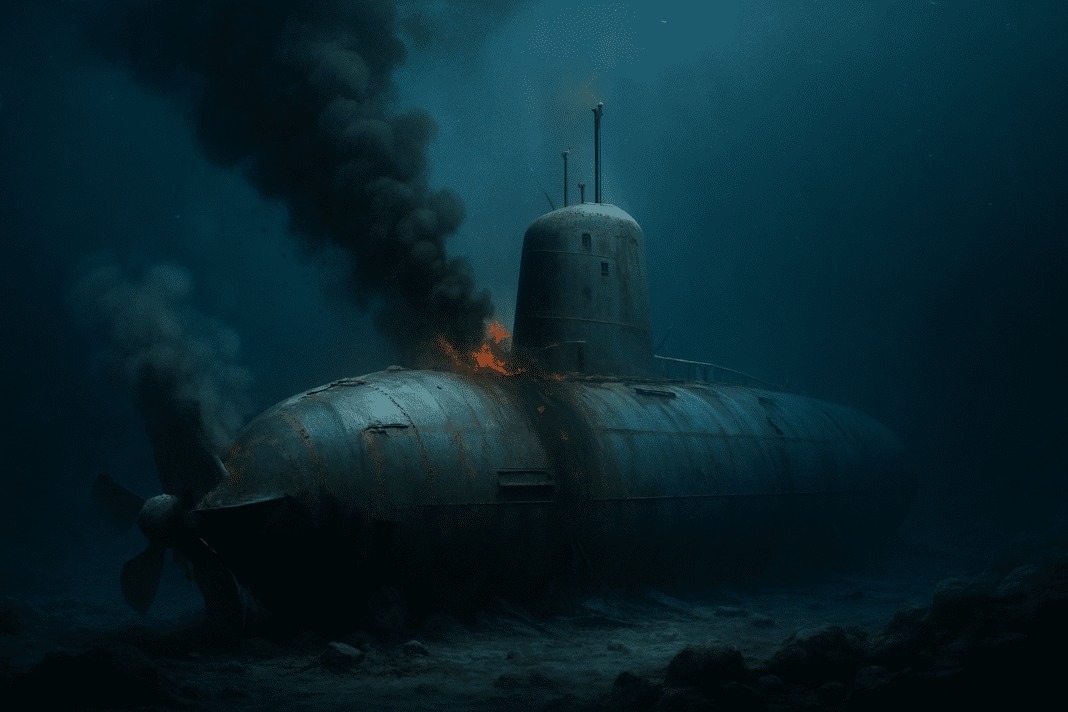The Soviet Union built the K-278 Komsomolets, also known as Project 685 or the “Mike-Class,” as a unique experimental nuclear-powered attack submarine during the Cold War. Unlike typical submarines of that era, K-278 featured a titanium hull that enabled it to dive to unprecedented ocean depths. The Soviet Navy officially commissioned K-278 on August 4, 1984, and assigned it to the Northern Fleet.
K-278 Komsomolets: A Technological Marvel with Fatal Flaws
This vessel held the world record for the deepest recorded dive by a military submarine, descending to a depth of 1,020 meters (3,350 feet) in the Norwegian Sea. Its hull could theoretically withstand depths greater than 1,000 meters, far surpassing that of standard steel-hulled submarines. The choice of titanium, while expensive and technically challenging, offered both strength and corrosion resistance, making K-278 one of the most advanced submarines ever constructed.
Despite its engineering brilliance, the K-278 Komsomolets was designed as a prototype and never mass-produced. Only one unit was ever completed. It was intended to test deep-diving technologies and new combat systems. Equipped with six torpedo tubes, it carried Type 65 and Type 53 torpedoes, some with nuclear warheads. It also had an escape capsule for the crew — a feature rarely seen on other submarines.
🔥Russia shreds Cold War missile pact that once stopped WWIII after Trump deploys submarines
Fire and Sinking: The Downfall of K-278
On April 7, 1989, disaster struck. The K-278 submarine was cruising at a depth of 386 meters when a fire broke out in the aft compartment. The blaze began in the engine room due to an electrical short circuit, quickly spreading through the submarine’s compartments. The fire disabled the reactor’s cooling systems, putting the vessel at risk of a nuclear meltdown.
The crew tried to surface the submarine, and K-278 managed to rise to the ocean surface. However, even after surfacing, the fire continued to burn, and the onboard damage control systems failed to contain it. The submarine eventually sank in the Barents Sea, roughly 180 kilometers southwest of Bear Island, at a depth of around 1,680 meters.
Najib Razak Pulled Back Into RM5 Billion Submarine Bribery Scandal as French Files Resurface
There were 69 crew members onboard at the time. Despite the use of life rafts and an escape pod, 42 sailors lost their lives — most of them to hypothermia in the freezing waters while waiting for rescue. This incident marked one of the most significant non-combat submarine disasters of the Cold War era. The titanium hull of K-278, which had been a symbol of resilience, could not protect it from internal mechanical failure and fire.
Environmental Risks and Recovery Efforts
After the sinking, the K-278 submarine posed a new kind of danger — environmental. The vessel had a nuclear reactor and two torpedoes with nuclear warheads onboard when it sank. It rested at the seafloor at a depth that made salvage operations virtually impossible at the time.
In the following years, expeditions were sent to monitor the wreck. A series of underwater missions in the 1990s and 2000s confirmed that the submarine was leaking radioactive materials. Although the rate of leakage was not catastrophic, concerns about long-term contamination in the Barents Sea persisted. Protective measures, including sealing some parts of the hull, were carried out in subsequent years to reduce the risk.
Ukraine claims hack of Russia’s nuclear submarine ‘Knyaz Pozharsky’; files and combat plans exposed
The wreck of K-278 remains one of the deepest known nuclear submarine wrecks. It serves as both a historical monument to Cold War naval engineering and a somber reminder of the limitations of even the most advanced military technologies. The incident has led to greater awareness about safety in nuclear submarine operations and the environmental risks associated with sunken vessels.
Today, the K-278 Komsomolets continues to lie at the bottom of the ocean. Its location, technological complexity, and legacy as a deep-sea nuclear hazard have made it one of the most closely monitored submarine wrecks in the world. Despite its brief service life, the story of K-278 continues to impact naval protocols and environmental assessments of deep-sea military wreckage.

